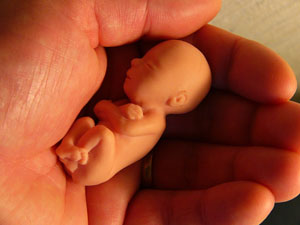Diagnostic Ultrasound
When and Why?
The Diagnostic Ultrasound in Pregnancy
– Why & When is it Used?
3. Calculating gestational age and assessing fetal size.
The gestational age of the fetus is reflected by fetal body measurements. This is predominantly the case in the first trimester. When patients are uncertain as to the date of their last menstrual period, these measurements must be made as early as possible in pregnancy to determine a correct dating for the patient.
In the later stages of pregnancy, measuring body parameters will allow assessment of the size and growth of the fetus and will greatly aid in diagnosing and managing intrauterine growth retardation (IUGR).

The following measurements are normally taken:
a) The Crown-rump length (CRL)
Crown-rump measurement can be made between 7 to 13 weeks with a diagnostic ultrasound and provides highly accurate estimation of gestational age. Dating using the CRL can be within 3-4 days of the last menstrual period.
It is important to note that when the due date has been set by an accurately measured CRL, it should not then be altered by a subsequent scan.
For instance, if another scan done 6 or 8 weeks later suggests that the due date is actually 6 or 8 weeks later than previously thought, the due date should not be changed, rather this should be seen as a suggestion that the baby is not growing at the rate expected.
b) The Biparietal diameter (BPD)
This refers to the diameter between the two sides of the head. This diameter is measured after 13 weeks gestation. It increases from around 2.4 cm at 13 weeks to around 9.5 cm at full term.
Different babies of the same weight can have different head size, making dating in the later part of pregnancy generally considered unreliable. Dating utilizing the BPD should be completed as early as possible.
c) The Femur length (FL)
The measurement of the longest bone in the body, reflecting the longitudinal growth of the fetus. The usefulness of this method is similar to the BPD via diagnostic ultrasound.
The measurement increases from around 1.5 cm at 14 weeks to around 7.8 cm at full term. Similarly to the BPD, dating using the FL should be done as early as possible.
d) The Abdominal circumference (AC)
This is the single most important measurement to make in the late stages of pregnancy. This measurement reflects more of fetal size and weight rather than age. Serial measurements are useful to monitor the growth of the fetus.
It is important to point out that AC measurements should not be used for dating a fetus.
Fetal Weight and Diagnostic Ultrasound
The weight of the fetus can also be estimated at any gestation with great precision through the use of polynomial equations containing the BPD, FL, and AC. Computer software and lookup charts are widely available. For instance, a BPD of 9.0 cm and an AC of 30.0 cm will provide a weight estimate of 2.85 kg.
4. Diagnosis of fetal malformation.
A large number of structural abnormalities in the fetus can be diagnosed reliably through an diagnostic ultrasound scan, and these can normally be diagnosed before 20 weeks. Typical examples are anencephily, myelomeningacoele, achondroplasia, dwarfism, spina bifida, and fetal hydrops.
Using more recent equipment, conditions such as cleft lips/ palate and congenital cardiac abnormalities are more easily identified at an earlier gestational age.
First trimester ultrasonic 'soft' markers for chromosomal irregularities such as the absence of fetal nasal bone, an increased fetal nuchal translucency (the area at the back of the neck) are now being commonly used to allow for detection of Down syndrome fetuses.
3D Ultrasound can also aid in other diagnostic procedures in prenatal diagnosis, for instance amniocentesis, chorionic villus sampling, cordocentesis (percutaneous umbilical blood sampling) and in fetal therapy.
In the next part of the diagnostic ultrasound guide, we will be discussing even more great details.
Site Contents
Pregnancy
- Getting Pregnant Tips
- Signs of Being Pregnant
- Pregnancy Warning Signs
- 3 Stages of Labor
- Good Sleeping and Pregnancy
- Sleep Hygiene and Tips
- Top 10 Pregnancy Questions
- Advantages of Natural Childbirth
- Why An Early Pregnancy Ultrasound?
- Why A Late Pregnancy Ultrasound?
- Gender Ultrasound Overview
3D Ultrasound
- What is a 3D Ultrasound?
- What's the Procedure Like?
- Reasons for 3D Ultrasounds
- Ultrasound Technology
- When & Why: Diagnostic Ultrasound
- Is a Prenatal Ultrasound Risky?
- Ultrasound Machine Risks / Safety
- Scheduling Your 3D Sonogram
- Preparing for 3D Baby Ultrasound
- Ultrasounds FAQ